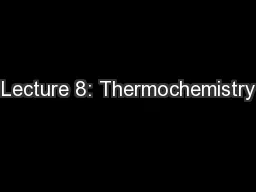

Lecture 8 Topics Brown chapter 5 81 Kinetic vs potential energy 51 82 Transferring energy as heat amp work Thermal energy 83 System vs surroundings ID: 613971
Download Presentation The PPT/PDF document "Lecture 8: Thermochemistry" is the property of its rightful owner. Permission is granted to download and print the materials on this web site for personal, non-commercial use only, and to display it on your personal computer provided you do not modify the materials and that you retain all copyright notices contained in the materials. By downloading content from our website, you accept the terms of this agreement.
Slide1
Lecture 8: Thermochemistry
Lecture 8 Topics
Brown chapter 5
8.1
:
Kinetic
vs. potential energy
5.1
8.2
:
Transferring
energy as heat & work
Thermal energy
8.3:
System
vs. surroundings
Closed systems
8.4:
First
Law of Thermodynamics
5.2
Internal energy of chemical reactions
Energy
diagrams
E, system & surroundings
8.5:
Enthalpy
5.3
Exothermic
vs. endothermic
Guidelines thermochemical equations 5.4
Hess’s
Law
5.6
8.6:
Calorimetry
Constant
pressure
calorimetry
8.7:
Enthlapy
of formation
5.7Slide2
Enthalpy of formation
Enthalpy of formation: enthalpy to form 1 mole
Enthalpies of formation can be used to calculate enthalpy of reaction.Slide3
standard states?
see table 5.3, p. 177 & appendix C
p.
183-5
The enthalpy of formation of any substance in its
most stable form is always zero
:
Carbon as graphite; oxygen as O2 gas; copper as an elemental solid (metal).
There are many forms (or expressions) of enthalpy including
H
vaporization
, Hfusion, Hcombination & Hformation. The most useful is standard enthalpy of formation (H°f): the enthalpy change that accompanies the formation of 1 mole of a compound from elements in their standard states.
Na? Hg? N2?
Write the reactions for H°f for:CH3CH2OHFePO4
2C + 1/2O2 + 3H2
CH3CH2OH
Fe + P + 2O2 FePO4
Enthalpy of formation (ΔHf)
The
form of the element at
1 atm, 298 K/25°C gases - 1 atm solutions - 1 M
s
olid
l
iquid
g
asSlide4
p. 183-5
a. 2Na(s) + 1/2O2
(g)
Na
2
O(s)
2K(l) + Cl
2
(g)
2KCl(s)
C6H12O6(s) 6C(diamond) + 6H2(g) + 3O2(g)Yes - all in standard states & 1 mole product is formedNo - K should be (s) & 2 moles product are formedNo - this is a decomposition, not a formation; reverse itExample: Δ
Hf
For which reaction (at 25°C) would enthalpy change represent standard enthalpy
of formation?If not, how could you change the reaction conditions?Slide5
p. 185-7
If we know the H
f of all reactants & products, we can calculate H
rxn
:
Propane (C
3
H
8
) is combusted to form CO
2
and H2O under standard cond.C3H8 + 5O2 3CO2 + 4H2O(gas) (gas) (gas) (liquid)C3H8 --> 3C + 4H23C + 3O2 --> 3CO2
4H2 + 2O
2 --> 4H2O H1
= -Hf [C3
H8(g)]
H2 = 3Hf [CO2(g)]
H3 = 4Hf [H2O(l)]
C3H8
+ 5O2 --> 3CO2 + 4H
2OH°rxn = H1 + H2 + H3
H°rxn
= -
Hf
[C
3
H
8
(g)] + 3Hf [CO
2
(g)] + 4Hf [H
2
O(l)]
= -(-103.85 kJ) + 3(-393.5 kJ) + 4(-285.8 kJ)
= -2220 kJ
reversed
state !
stoichiometry
(
moles)(kJ
/mole)
H°rxn
=
nH°f(products
) -
nH°f(reactants
)
So this concept combines Hess’s Law with
H
f
.
Expressed via Hess’s Law:
Δ
Hfs
can be summed to calculate
ΔHrxn
Slide6
p. 185-7
Calculate the H for combustion of 1 mole benzene (C6
H6).
C
6
H
6
+ 15/2O
2
6CO2 + 3H2O(liquid) (gas) (gas) (liquid)Hrxn = [6Hf(CO2) + 3Hf(H2O)] - [Hf(C6H6) + 15/2 Hf(O2)]
= [6(-393.5 kJ) + 3(-285.8 kJ)] - [(49.0 kJ) + 15/2(0 kJ)]= (-2361 - 857.4 - 49.0) kJ
= - 3267 kJ
products
reactants
Use enthalpies of formation to calculate the Hrxn for: CaCO3(s) --> CaO(s
) + CO2(g)Hrxn = [Hf(CaO) + Hf(CO2)] - [Hf(CaCO3)]= [(-635.5 kJ) + (-393.5 kJ)] - [(-1207.1 kJ)] = 178.1 kJ
products
reactantsExamples: ΔHfSlide7
p. 188-9
Carbohydrates? Glucose = C6H12O6
What about industrial fuels?
fuel value
(kJ/
g
)
Coal
31 - 32 Oil 45 Natural gas 49 Gasoline 48 H2 142Fats? Triacylglycerol (body fat) = C57H110O6C6H12O6 + 6O2 6CO2 + 6H2O Hrxn = - 2803 kJ
Average fuel value for carbohydrates (& proteins) is ~17 kJ/g.
2C57H110O6 + 163O2 --> 114CO2 + 110H2O Hrxn = - 75,520 kJ
Average
fuel value for carbohydrates (& proteins) is ~38 kJ/g.
Enthalpies of combustion of fuels